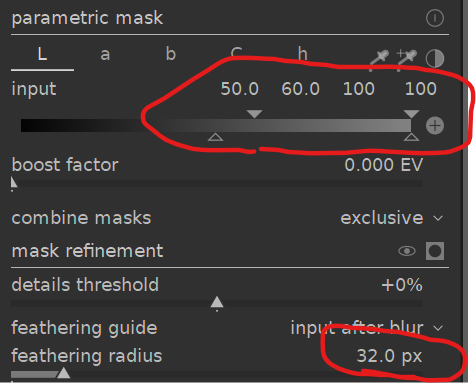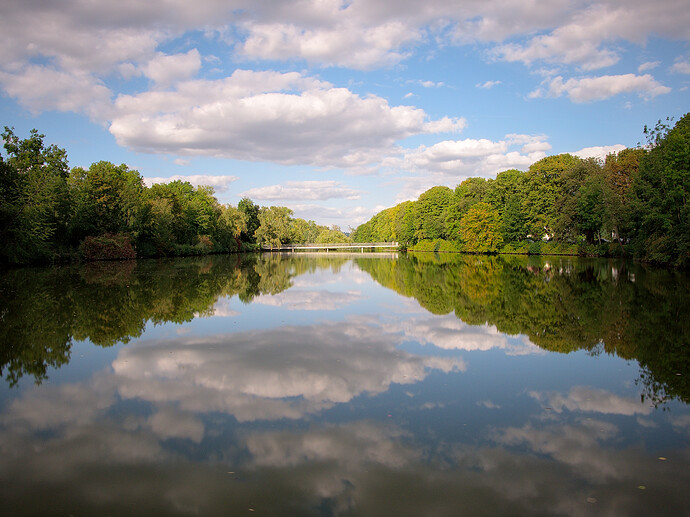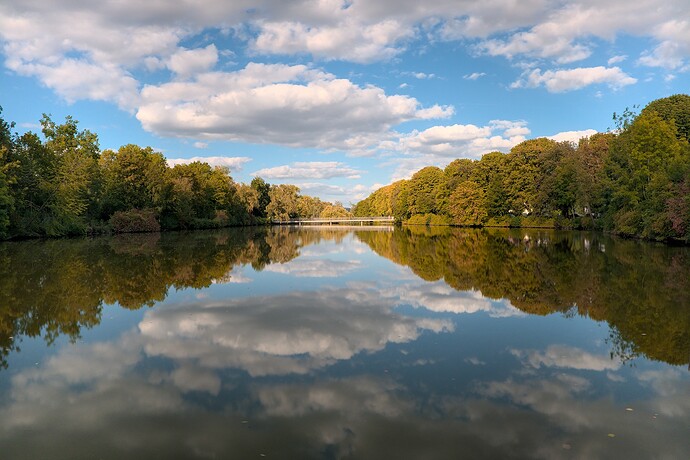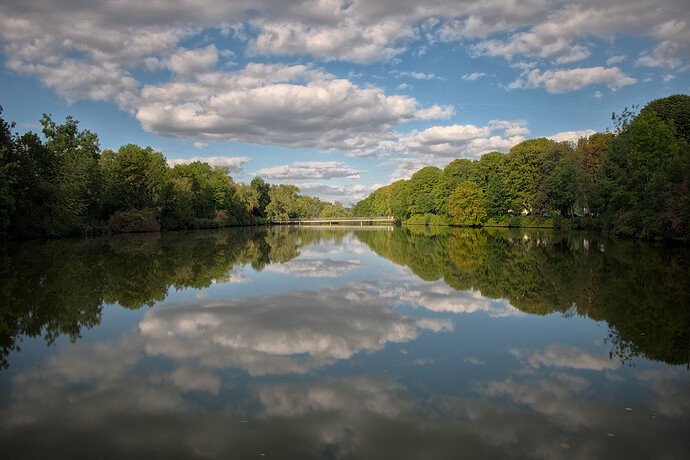It has a trick… the reflection changed places.
It is not the reference, but one of many possibilities.
The tone equalizer is recommended as a replacement for shadows and highlights.
But I can’t get the same result as with shadows and highlights.
I also can’t get the same result with it as someone else did with the Tone equalizer unless I know the individual values for the sliders.
I think this is due to the setting of the mask.
But I probably just don’t have the experience here. Nevertheless, I find it very difficult in contrast to other modules.
The algorithm of shadows and highlights may be worse and work in non-linear color space. But the module is simpler and if I like the result for a photo, then why should I use the more complex module.
It’s simpler because it takes shortcuts, and those shortcuts will come back in your face when you least expect it. Broken clocks still give the accurate time twice a day, doesn’t mean you should trust them in general.
I think Tone Equalizer not only is technically superior, but can be used with the same ease.
My favourite preset I created is “Fill light”, as in the screenshot below:
Once applied, I can control its power just by playing with opacity slider.
In my case it is [almost] always so linear, because I find small, gradual changes to be most pleasing and natural to human eye.
That covers the “Shadows” part - if you need to control “Highlights”, you can create a reverse preset 
My take, DT 3.9
Maybe I am OT, but I find Tone Equalizer is not needed at all here, the problem with the trees is largely due to the strong lens vignetting.
So I used the modules lens correction and exposure (with masks) to fix it locally.
I find that is always better to use local corrections when possible, it makes the job of global tone adjustment modules so much easier.
190918-T10X2232.raf.xmp (12.2 KB)
that is nicely done
I tried to load your sidecar to compare with your comments but doesn’t seem to be in the jpg if its the same for others then you could you add your sidecar…
Ooops forgot to attach the xmp, added now
We need to be able to share your “geniusness” 
‘Simplicity’ is depending on who thinks what of which module :). S&H is ‘one click to get an effect you like’, and if you like it, that’s fine.
But what it’s doing is local-contrast and certain areas get brighter, so basically doing two things at once.
Now imagine you only want the tone to be brighter but not mess with local contrast. S&H is then a nightmare for a lot of people :). In your case (original topic starter), it does exactly what you wanted. Nice. There are a lot of people (but I don’t know if they are more or less… and I don’t care) that think ‘hey, what is happening here?’.
Starting from modern flow defaults, what I did: (there is no good or wrong here)
- Disable highlight reconstruction (nothing to reconstruct)
- Set filmic’s ‘dynamic range scaling’ to +10%, then hit the auto button next to it
- Raise exposure until I like the shadows in the corner (I ended up using +2ev)
- Highlights are now too ‘high’. Filmic can roll them off, but that looses too much local contrast / detail there. So I use the tone equalizer to lower highlights, not boost shadows.

- Enable tone equalizer, and I pick up the module and move it before the exposure module (so ‘under’ it in the list). Why? Exposure didn’t raise anything yet at this point, so the highlights are all still workable and visible without having to mess with the mask. I set 0ev to -0.45, -1ev to -0.75, -2ev to -0.75 and -3ev to -0.45 and leave the rest.
- I go to filmic and hit the auto button next to dynamic range scaling once again, to let it reset white/black points.
- Enable ‘color balance rgb’ with the ‘add basic colorfulness’-preset
- ‘clarity in the highlights’ trick: enable ‘local contrast’ in ‘bilateral grid’ mode. Set contrast to 3, and detail to 400% (yes, 400%). Enable the ‘parametric mask’ with L values of ‘50.0 60.0 100 100’. So the mask only works on L values above 50 (and slowly increases between 50 and 60). Set the feathering radius to 32px to make the mask a bit better around the edges.
 The billateral effect now only works on ‘highlights’.
The billateral effect now only works on ‘highlights’. - Add another instance of ‘local contrast’ but keep it at the defaults of ‘local laplacian’.
- Image is now done, add the finishing touches with heavy modules
- Set the demosaic module to markestijn 3-pass (absolutely no clue what to pick with xtrans files, not used to them. But I had some artifacts in the corners which were (almost) gone when switching from 1pass to 3 pass. Could also be artifacts of my 3.9 dev-build ?
- I noticed some purple fringing in the corners. I enabled ‘chromatic aberrations’ with radius 6 and strength 1.
- Enable diffuse with the ‘sharpen demosaic (no-AA)’ preset.
- Add another instance of diffuse with the ‘lens deblur: medium’ preset.
The core of the settings are to raise exposure more than normally, and reduce the highlights in a curve-like manner with TE without messing with any of the mask parameters)… and then add some local-contrast with the default local-contrast module.
The bilateral ‘trick’ is for taste, not for the shadowy-corners. The diffuse is for sharpening (but might very well help with ‘detail in the leaves’ of the darker parts) and can be adjusted to taste, or maybe replaced with the ‘fast sharpness’ preset for performance?
Also, the numbers used are more rounded, so the edit can be ‘redone’ easily. Normally I just drag or click the slider, but I rounded the values for ‘easy repeating’.
190918-T10X2232_05.raf.xmp (14.7 KB)
Absolutely not saying you have to like it, but just a way of doing it without messing too much with mask parameters and trying to stick to presets.
Another quick way would be to raise exposure normally, and then use TE with the ‘compress shadows/highlights: soft’ preset. And then reset the highlight values of the curve in the ‘simple’ tab (so it becomes a compress-shadows-preset). Combined with some sharpening and local-contrast-module at the end, it seems to give good results without turning the corners details to mush. (which indeed is happening when just using TE I noticed).
Is this the embedded Jpg vs your edit…sorry I scanned a couple of times and didn’t see what the two images were comparing…
No, a 1200 wide version (like the OP) and a full res download. So you should not see any differences 
Is this plugin available for download.thanks
What plugin??
David talks about a custom plug in for gimp that he made. Hopefully David sees my question.
Just seen your question. The plug-in was available on the gimplearn website, but unfortunately that site is down at the moment.
I have attached a zipped version - I hope that is allowed.
It goes in the plug-ins folder and linux users will need to make it executable.
Feedback on its usefulness would be appreciated.
eq_lum_mask_h_m_s.zip (2.5 KB)
Thanks David. I will try and test it out. I know some people swear by luminosity masks, but I have struggled to get results that look natural across the gradients of tones. Hopefully I will have some luck with your version because you have some overlaps.
Have you also tried the tone eq in Art. It has a nice color display of the zones …bit like a heat map and you can target them after evaluating… It quite effective and can be coupled to the log tone mapping module…just another option





